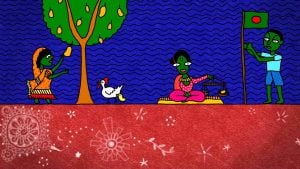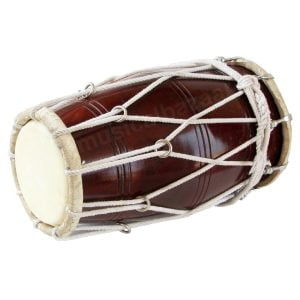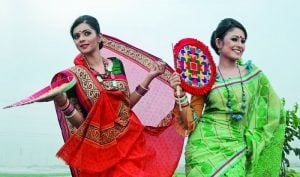Art and Culture of Bangladesh

Bangladesh is rich in its own culture and heritage. In general, it has a mixed culture with the impact of different religions and traditions. Mainly, the art and culture of Bangladesh have been built with the combination of Islamic, Hinduism and Buddhist culture. She has kept enriching contributions to cultural variants, including literature, music, architecture, music, drama, painting and dance. With the impact of time and order, the generation has kept a culture of their own.
Festivals:
The religions mainly influence the festivals of Bangladesh. For example, Muslims celebrate Eid (Eid-ul-Fitr and Eid-ul-Azha), Muharram and Eid-e-Miladunnabi. At the same time, the Hindus observe different festivals (Puja), including Durga Puja, Krishna Janmashtami, Kali Puja, Diwali, Saraswati Puja, and many more pujas. Similarly, Christians observe Christmas Day (Also known as Baradin in Bengali) and Buddhists celebrate the festivals, including Vesak (Also known as Buddha Purnima in Bengali). On the other hand, the Bengalis observe some traditional and historical festivals countrywide, forgetting the religions, castes, and colors. For example, Pahela Baishakh (Reason: the first day of the Bangla Calendar year), Independence Day (26th March), 21st February (International Mother Language Day), The Victory Day (16th December), Lalon, Rabindra & Nazrul Jayanti, etc.
Literature:
Bangladesh is very rich in literary heritage. Before the thousand years and during the medieval period, Bengali literature started to blossom and keep a footprint. When the Muslim rulers were in this subcontinent, the literature developed continuously. We see the famous poet Chandi Das, Alaol, and Daulat Kazi. Then, the advent of Michael Madhusudan Dutt, Lalon, Rabindranath Tagore, and Nazrul Islam made Bangla literature more widespread. We can’t deny the contribution of Bankim Chandra Chattopadhyay, Sarat Chandra Chattopadhyay, and Syed Mujtaba Ali. Thus, many pioneers in Bangladesh literature, Bangla, have gained recognition as an exuberant language.

Music:
The folk song of Bangladesh is noticeable. The spiritual view on the lyrics and the philosophical concept has made them immortal. Lalan Fakir, Hasan Raja, and many of the anonymous lyricist’s lyrics have enriched the folk and spiritual song. We see the folk music arena, including Jari, Shari, Murshidi, Bhatiali and similar types of folk music in Bangla. The impact of Rabindra Sangeet and Nazrul Sangeet is splendid in Bangla songs. It is considered a precious heritage in the Bangla Music industry. On the other hand, the impact of Western songs, including pop songs, has increased a lot with the contribution of the different popular band groups.
The use of Bangladeshi musical instruments is noticeable, and it is also a part of our culture. For example, Banshi (The flute made of bamboo), Dhole (Drums made of wood), Ektara (Musical Instrument with a single-stringed), Dotara (Musical Instrument with a four-stringed), Mandira (A rhythm instrument made of a pair of metal bawls) and many more. Nowadays, the use of Western instruments is also increasing alongside country instruments. For example, I use Guitars, drums, synthesizers, and saxophones.
Painting:

Zainul Abedin has pioneered the modern painting in Bangladesh. The contributions of SM Sultan, Kamrul Hassan, Shafiuddin Ahmed, and Anwarul Haque are impressive. In 1943, Zainal Abedin’s sketches on famine brought international popularity to Bangladeshi painting. The painting focused on the culture and tradition of Bangladesh. In the present time, the artists are also participating on the international stage, including Abdur Razzak, Murtaza Baseer, Debdas Chakraborty, and Qayyum Chowdhury.
Drama:
Drama is performance-based fiction, and Bangladesh practiced the culture for many days. In general, the drama in Bangladesh is written by local writers as well as they adopt stories from famous writers around the world. In Dhaka, you will find dozens of theater groups who are staging drama regularly. Dhaka’s most popular and active theatre groups are Dhaka Theatre, Nagorik Natya Sampradaya and Theatre (Baily Road). A place in Dhaka City named Baily Road which is known as “Natok Para” for staging Drama regularly. The Public Library Auditorium, TSC, or Museum Auditorium are famous for cultural shows and creative programs. Dhaka University areas are a famous and pivotal part of Bangladesh for participating in cultural shows or activities.
Dance:

Bangladeshi dance is formed with the similarity of classical forms of the Indian subcontinent. Other types of dancing we have are folk, Middle Eastern and tribal. The common tribal dances are Monipuri and Santal, which are very famous. In the rural areas in Bangladesh, they also practice dances but don’t follow any exact format or rules. The song of Jari or Shari is also presented by the local traditional group. The impact of Western Dance is also seen in the Bengali culture.
Jatra:
Jatra is a form of folk drama from the ancient culture of Bangladesh. At the rural level, it is presented regularly as a form of entertainment. In general, it focuses on the love and tragedy from mythological episodes. The rural people love the Jatra as the most significant part of the show. However, the impact of Western Culture has decreased the number of participants and the staging of Jatra. Still, on special occasions or festivals, we see the popularity of Jatra.
Traditional Transportation Means:
Some unique types of transportation systems are seen in Bangladesh and they are also part of our heritage. For example, TomToms (Transportation by horse) is used in the old Dhaka. At the same time, the Bi-Cycle and Rickshaws are found in rural and urban areas all over Bangladesh. The occasional use of Palki is also a heritage of our land. It is a box-like vehicle that is carried by the shoulders of the six men. In general, it is used in the wedding celebrations.
On the other hand, using a boat in the river (Nawka) of Bangladesh is very common. It is one of the popular means of communication in Bangladesh. At the same time, VANs and other types of vehicles are used in rural areas or carrying goods in urban areas.
Clothing:

In Bangladesh, the women wear Sarees and the Men wear Panjabi, Pajama, Fotua, and Pajamas. Jamdani was very famous all over the world for its artistic design and it was very expensive as well. Moslin – another artistically amazing cloth for women, was very popular worldwide. Naksi Kantha is produced with handwork by village women in Bangladesh and is still very familiar to Bangladesh. A very common hairstyle in Bangladesh is Beni, which is done by the Bangalee Women. The use of the Lungi of the Men is huge. At the same time, the Hindus use Dhuti – another type of cloth that is used for religious purposes. Nowadays, the use of Shirts and Pants for Men and Salwar and Kameez for Women and girls is increasing. The use of Western Cloth is also increasing day by day.
Cultural Institute:
Many Government and Non-government organizations are working to enrich Bangladeshi art and culture. For example, Bangla Academy, Bangladesh Shilpakala Academy, Nazrul Institute, Fine Arts Institute, and Chhayanat. They work in every sector to save and enrich Bangladesh’s traditions and culture, including music, literature, drama, recitation, art, dance, etc.
To know more about the Art and Culture of Bangladesh, visit Bangladesh. Contact us for help and information.
